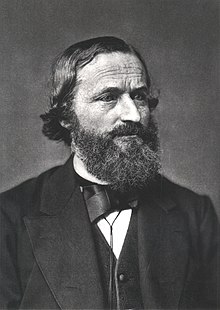
Back قانون كيرشهوف للإشعاع الحراري Arabic Закон выпрамянення Кірхгофа Byelorussian Kirchhoffs lov (termodynamik) Danish Kirchhoffsches Strahlungsgesetz German Leĝo de Kirchhoff pri radiado Esperanto Ley de Kirchhoff de la radiación térmica Spanish Kirchhoffi kiirgusseadus Estonian Erradiazio termikoaren Kirchhoffen legea Basque قانون تابش حرارتی کیرشهف Persian Loi du rayonnement de Kirchhoff French

In heat transfer, Kirchhoff's law of thermal radiation refers to wavelength-specific radiative emission and absorption by a material body in thermodynamic equilibrium, including radiative exchange equilibrium. It is a special case of Onsager reciprocal relations as a consequence of the time reversibility of microscopic dynamics, also known as microscopic reversibility.
A body at temperature T radiates electromagnetic energy. A perfect black body in thermodynamic equilibrium absorbs all light that strikes it, and radiates energy according to a unique law of radiative emissive power for temperature T (Stefan–Boltzmann law), universal for all perfect black bodies. Kirchhoff's law states that:
Here, the dimensionless coefficient of absorption (or the absorptivity) is the fraction of incident light (power) that is absorbed by the body when it is radiating and absorbing in thermodynamic equilibrium.
In slightly different terms, the emissive power of an arbitrary opaque body of fixed size and shape at a definite temperature can be described by a dimensionless ratio, sometimes called the emissivity: the ratio of the emissive power of the body to the emissive power of a black body of the same size and shape at the same fixed temperature. With this definition, Kirchhoff's law states, in simpler language:
In some cases, emissive power and absorptivity may be defined to depend on angle, as described below. The condition of thermodynamic equilibrium is necessary in the statement, because the equality of emissivity and absorptivity often does not hold when the material of the body is not in thermodynamic equilibrium.
Kirchhoff's law has another corollary: the emissivity cannot exceed one (because the absorptivity cannot, by conservation of energy), so it is not possible to thermally radiate more energy than a black body, at equilibrium. In negative luminescence the angle and wavelength integrated absorption exceeds the material's emission; however, such systems are powered by an external source and are therefore not in thermodynamic equilibrium.
- ^ Kirchhoff 1860
- ^ Planck 1914
- ^ Milne 1930, p. 80
- ^ Chandrasekhar 1960, p. 8
- ^ Mihalas & Weibel-Mihalas 1984, p. 328
- ^ Goody & Yung 1989, pp. 27–28
© MMXXIII Rich X Search. We shall prevail. All rights reserved. Rich X Search